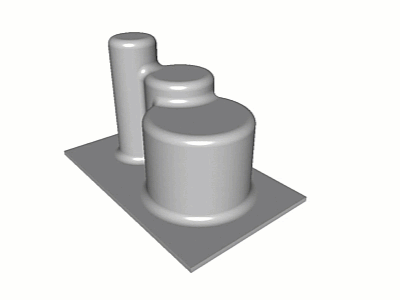Introduction
This release of BobCAD-CAM V37 offers more functionality than ever before. This version has 36 upgrades and enhancements affecting the following areas:
- General
- CAD
- BobART
- CAM
- Simulation
The BobCAD-CAM V37 release is available in the following languages:
- English
- Spanish
- German
- Turkish
- Japanese
- Czech
- Portuguese
CAD
View Rotation Keys
In this release, you can pan and rotate the view with the keyboard arrow keys. While you have always been able to control the view with the mouse, previously the only means of adjusting the view of the graphics area with the keyboard was with the + and - keys to adjust the zoom. Now, you can use the arrow keys and arrow keys with the Shift/Ctrl/Alt modifiers to rotate and pan.
Arrow Keys
By using the Arrow Keys you can automatically rotate in 90° increments. Use the left and right arrows to rotate around the vertical axis of the current view, and up and down arrows to rotate around the horizontal axis of the current view.
| |
Up Arrow
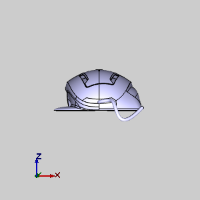
|
|
|
Left Arrow
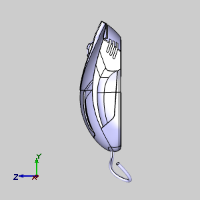
|
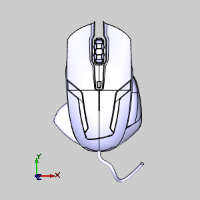
|
Right Arrow
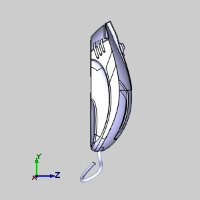
|
| |
Down Arrow
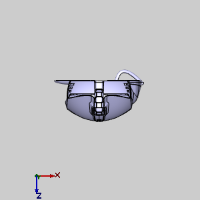
|
|
Shift + Arrow Keys
By using Shift with the Arrow Keys you can automatically rotate in 15° increments. Use Shift with the left and right arrows to rotate around the vertical axis of the current view, and with the up and down arrows to rotate around the horizontal axis of the current view.
| |
Shift + Up Arrow
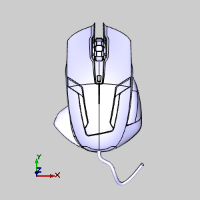
|
|
|
Shift + Left Arrow
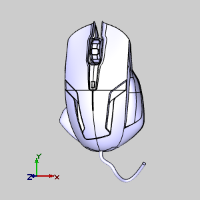
|

|
Shift + Right Arrow
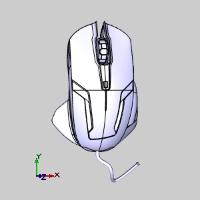
|
| |
Shift + Down Arrow
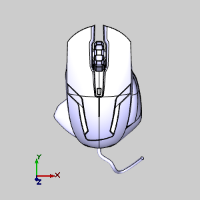
|
|
Ctrl + Arrow Keys
By using Ctrl with the left and right Arrow Keys you can automatically rotate in 90° increments along the current view.
|
Ctrl + Left Arrow
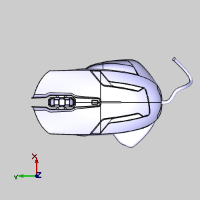
|

|
Ctrl + Right Arrow
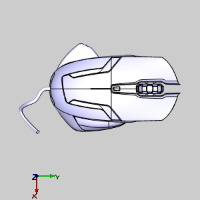
|
Views to Active UCS
BobCAD-CAM now offers an option to set your views based on the UCS that you're using. Using the view options is always a huge help. Hopping quickly into your top, front, and isometric views goes a long way to help you get a clear picture of the design direction, and even the machining direction you should be going in during your jobs. However, when you start working on different coordinate systems, those views start to confuse a little more than they help. With our new Views to Active UCS option, simply click the  icon in the status bar, and all the views display in relation to the currently coordinate system you're working in!
icon in the status bar, and all the views display in relation to the currently coordinate system you're working in!
- View to Active UCS: Off
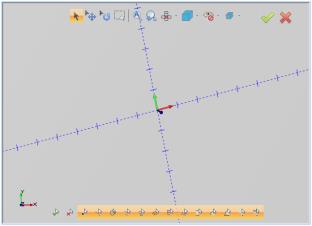
When working in a User Coordinate System (UCS) that is askew from the World Coordinate System (WCS), moving into a top view sets the view based on the WCS. Notice how the WCS gnomon in the lower left of the graphics area is oriented in the top view, while our UCS axis and gnomon remain askew.
- View to Active UCS: On
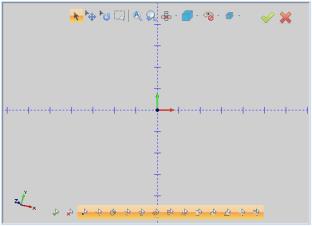
With the View to Active UCS toggle on, the view is based on the UCS. Notice how the WCS gnomon in the lower left of the graphics area is askew, while our UCS axis and gnomon are oriented in the top view.
Advanced Holes
BobCAD-CAM's new Advanced Holes feature allows you to create complex 3D holes, and even assign threading information to them, just by selecting the locations and entering the desired values! In the past, our Extrude Cut feature went a long way in making CAD design quick and easy. By extruding and subtracting in a single function, design time could be drastically reduced. The only trouble was, if you wanted a counterbore, you needed another arc, and another Extrude Cut function. If you needed a chamfer you'd have to go to the chamfer function next. And if you wanted to represent the drill tip angle you would need to tackle it a whole different way. With our new Advanced Holes function, simply pick the points, enter the desired dimension, and you're done; drill tip and all. Not only that, but you can assign thread information to the holes you create. With threading information attached, proper tools and depths are set automatically when you use the new Hole Recognition feature to toolpath your part!
| Holes |
Holes with Chamfer |
Holes with Counterbore |
Combination Holes |
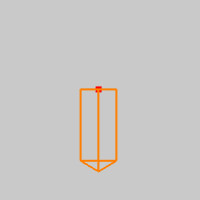
|
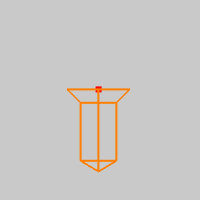
|
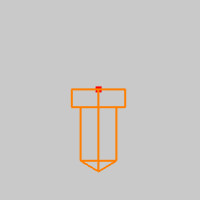
|
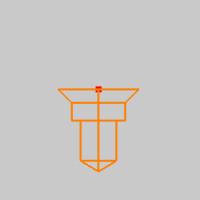
|
| Points Placed |
Holes Created |
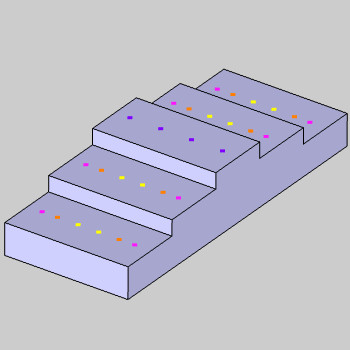
|
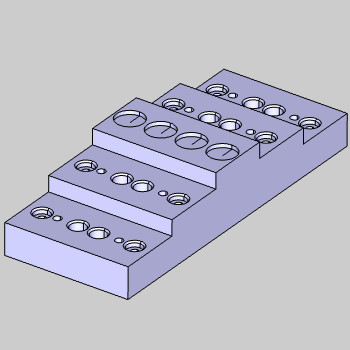
|
In the example used above, we created 4 different hole types in 28 different locations in under 2 minutes.
Add Property
The New Add Property function allows you to assign geometry thread information to be read by the Hole Recognition feature. While the Advanced Hole feature can automatically attach this information when creating complex 3D holes, existing part files may not have this information on the attached to the entities being machined. Whether your existing part file is a 3D model, or even just points and arcs indicating areas to be tapped, the new Add Property feature will allow you to tag each entity so the job can be done as quickly as possible with the Hole Recognition feature.
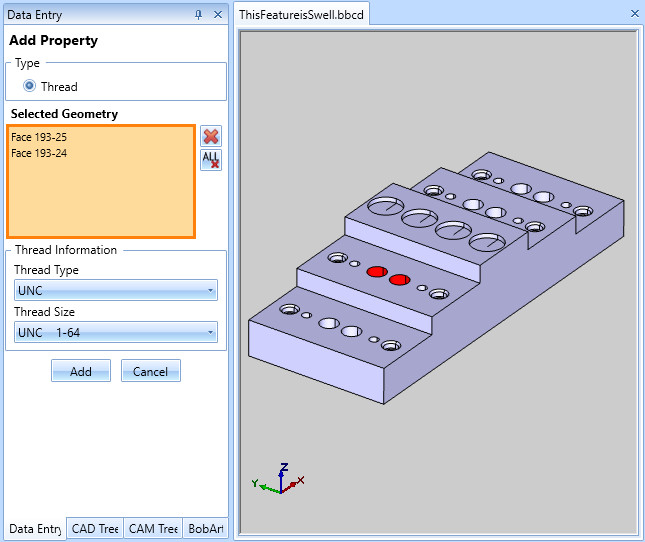
Edit Property
Once properties have been assigned to geometry with the Add Property function, the new Edit Property function will allow you to adjust the previously assigned values with ease! The filter drop down shows all thread sizes available for editing. With a particular thread size selected, all geometry with that thread size will be listed. Simply select the desired geometry and update it with the new thread information.
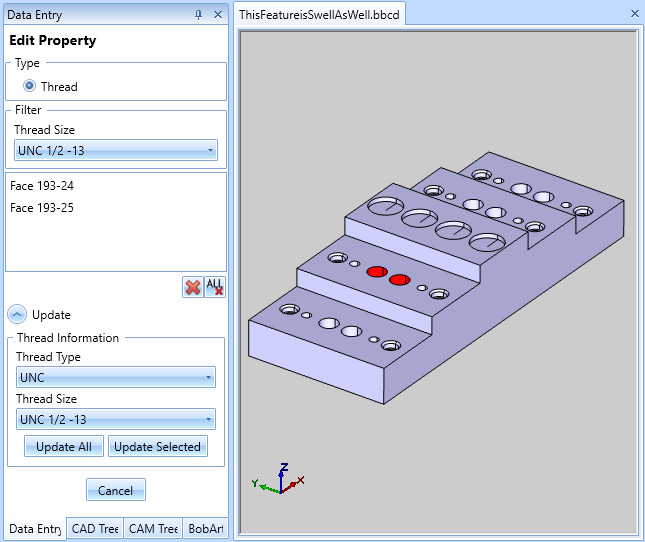
Align to Coordinate System
For the first time ever, BobCAD-CAM now offers a way to quickly rotate and translate geometry into a particular location and orientation at the same time. Occasionally, when you bring a part into BobCAD it can be located in what may look like an odd place and orientation. In many cases this is because it was a part of an assembly, in which its seemingly odd placement would make sense. Whatever the reason for its orientation, if you did want to move it and rotate it, having to figure out the angles to rotate in which axes can be tricky. Now, with the new Align to Coordinate System function, you can quickly define the coordinate system of the part(s) to be moved, define the coordinate system you want it to move to, and you're done!
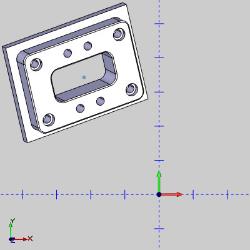
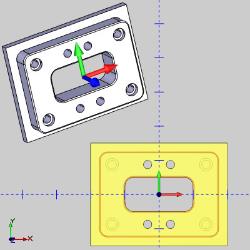
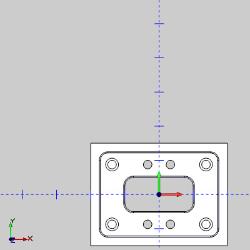
BobART
In order to give users all the flexibility they need, BobCAD-CAM now offers a solution for Flat End V-Tools. In the past there was no parameter to define a flat end on V-Tools. This could cause an issue in certain cases. By allowing users to enter a Flat End Diameter parameter and updating the toolpath to accommodate that parameter, you can be sure your final part comes out perfect every time!
| No Flat End Diameter
|
Flat End Diameter
|
|
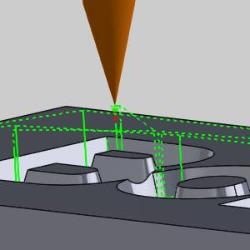
|
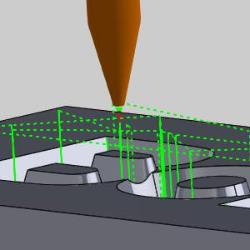
|
CAM
Probing
BobCAD-CAM now offers probing cycles with the new Probing module! Everything in the machine shop is about precision, and because of this probing is becoming an indispensable part of machine shop. Being able to verify work and tool offsets with 100% accuracy, check tools for breakage, and even inspect finished parts can save and enormous amount of time and money, and now BobCAD-CAM has everything you need to bring your shop to the next level.
The Probing package allows you to use the following operations:
| Probing
|
Contact Tool Setter
|
Non-Contact Tool Setter
|
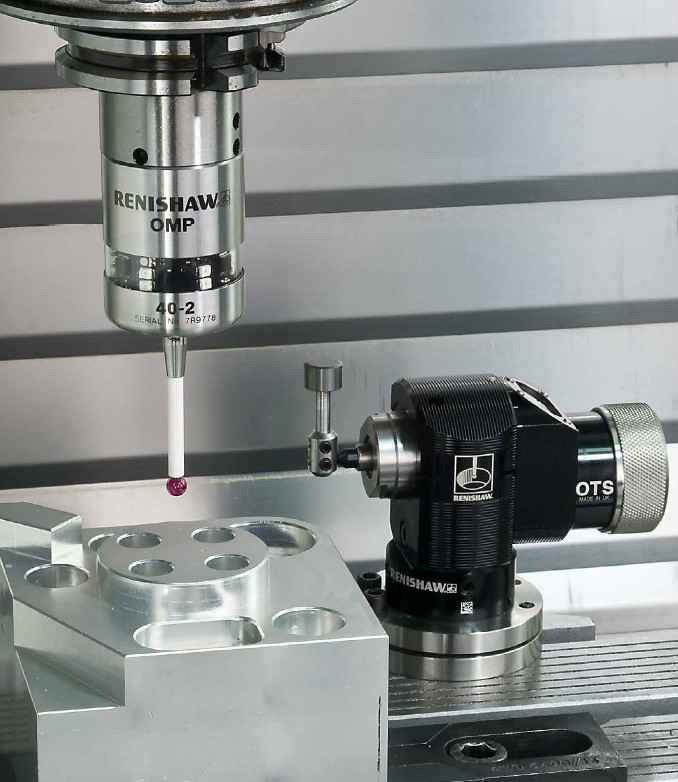
|
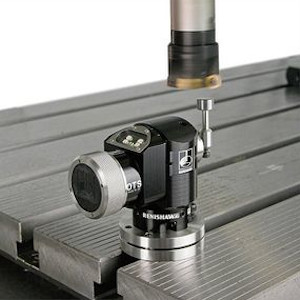
|
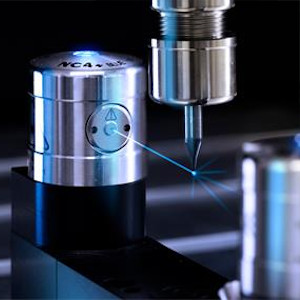
|
Between these three operations there are a total 41 different cycles available that include:
- Measuring Cycles
- Contact Tool Setter Cycles
- Non-Contact Tool Setter Cycles
- Calibration Cycles are not included
General
MachiningCloud Import
BobCAD-CAM V33 is the first release ever to offer a way to bring MachiningCloud tool assembly exports directly into your BobCAD-CAM Tool Crib, or Tool Library. In the past, having an accurate tool to simulate, meant figuring out how to design it, then designing it, then going into your library to assign that newly created geometry to the proper tool. The same went for your tool holder and your arbor. Now that you can import MachiningCloud jobs, this all happens automatically. Finally, you can have the most accurate tool geometry possible for accurate gouge checking, and accurate simulation of your mill and lathe tools with none of the headache!
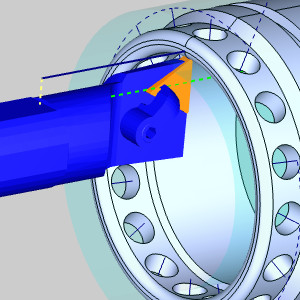
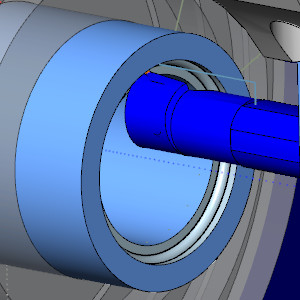
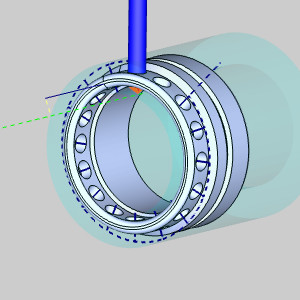
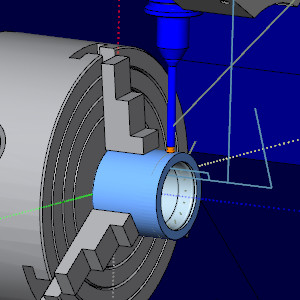
Whether you are backplotting or simulating, have the exact geometry for your tools is a game changer!
In order to allow import from outside sources BobCAD-CAM now offers its tool library in xml format. While users have always been able to share tool libraries with other users, tool import has only been possible between users of the BobCAD-CAM suite of software's. We have had many requests to give outside parties, like tool vendors, the ability to import their tools into our software. Now, with the tool library in an easy to read/write xml format, simply format your tool list to match, and bring it on in!
Mill
Mill Express
Corner Slowdown
With the new Corner Slowdown option you can cut your feedrate to specified percentage when you approach corners. When programming speeds and feeds many things need to be taken into consideration, especially ensuring the tool does not engage too much material at the same time since this can easily break a tool. When moving around a part, additional stock is always encountered in the corners.
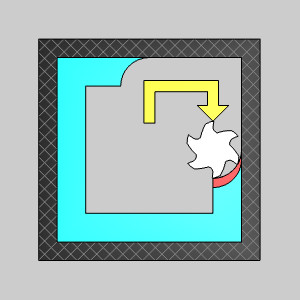
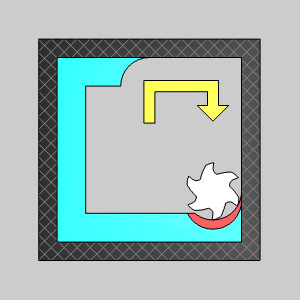
Notice how much additional material this tool engages in the corner. While you want to remove material as quickly as possible, scenarios like this have to be accounted for, and until now, that meant having to slow the speed on the rest of the path as well. Now, with the new Corner Slowdown feature, simply specify how close to get before the corner, and the percentage to slow the feedrate down to and you're done!
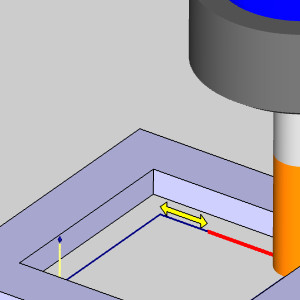
The toolpath is broken and the feedrate is dropped by the specified percentage.
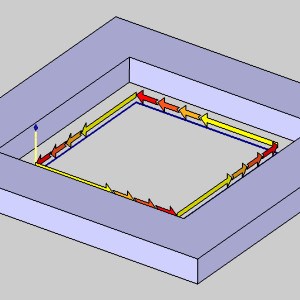
This feature will even allow you to divide the specified distance into a number of segments so the feedrate gradually drops to the specified feedrate percentage! Now, you can finally set your speeds as fast as you can, and handle the corners just how you need them to be.
New Pecking Options
One of the most frequently requested features has been to include pecking options in more hole operations. In this release, BobCAD-CAM is giving you just that! While pecking has been an option in standard drill operations since the beginning, other operations have not had that functionality available. In this release you will find pecking options in the following operations:
- Mill
- Center Drill
- Counterbore Drill
- Chamfer Drill
- Ream
- Lathe
- Lathe Center Drill
- Lathe Chamfer
- Lathe Ream
| Center Drill |
Chamfer Drill |
Counterbore Drill |
Ream |
|
|
|
|
|
New Side Roughing Options
Never have there been more options available when using the Profile Side Roughing pattern. This feature of the Profile Rough operation has had its options redesigned to allow you to set the stepover distance one of two ways, give you Zig Zag cut options in stepover and depths, provide linking options for the stepovers, and even cut order options to handle slices vs passes! In previous versions, the stepover for Side Roughing could only be defined by specifying the stock remaining and the number of cuts desired, all cuts would follow the same direction, and when using multiple depths each full depth was completed before the next.
| Number of cuts |
Direction of cuts |
Order of cuts |
|
|
|
|
This worked well in most cases, but now we provide ample options to handle just about any case!
The number of cuts can now be defined with the number of cuts and:
| By Stock Remaining |
By Stepover |
|
|
|
How the tool moves toward the geometry can now be determined with either a Zig, or Zig Zag cut.
| Direction of cuts on each pass |
| Zig |
Zig Zag |
|
|
|
How the tool moves from depth to depth can now be determined with either a Zig, or Zig Zag cut as well.
| Direction of cuts by slice |
| Zig |
Zig Zag |
|
|
|
These choices work in tandem to give you 4 different ways to define the direction of each cut.
| Zig / Zig |
Zig / Zig Zag |
Zig Zag / Zig |
Zig Zag / Zig Zag |
|
|
|
|
|
Moreover, you now have another option to define the order in which the cuts are made!
| Sort by: Slices |
Sort by: Passes |
|
|
|
Either of the above options can be applied to the cuts you create. This means every one of the direction options can be ordered in one of two ways, giving you 8 choices for handling cut direction and the order of those cuts!
Hole Feature Recognition
We have taken Hole Feature Recognition to a whole new level in this release. Now, with a single click we recognize all four hole types, and their variations!

The machining features are automatically created based on a customizable set of rules in our new knowledge base, and all can be computed at once! In this release, feature recognition has been broken into several parts to give you the most control possible, while keeping things simple:
- Step 1 – Launch Hole Recognition
- Step 2 – Review found hole features
- Step 3 – Done! All holes machined
Multiple Drill Tip Positions
A single Pocket operation can now have multiple drill tip positions assigned to it. In the past, although drill tip positions were allowed, only a single point was allowed per operation. This meant that if you had a pocket that created multiple regions, only one of those regions could be assigned a drill tip position. In this latest release, you can assign as many drill tip positions as necessary for a single pocket operation!
| No Drill Tip Positions
|
Drill Tip Positions Selected
|
Drill Tip Positions Computed
|
|
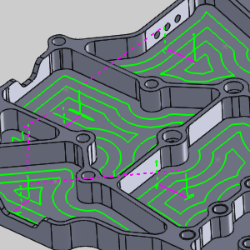
|
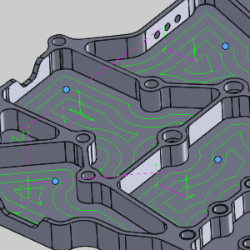
|
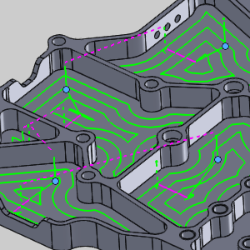
|
When working with Advanced Pockets, you can even apply multiple drill tip positions to a single pocket area with multiple regions.
| No Drill Tip Positions
|
Drill Tip Positions Selected
|
Drill Tip Positions Computed
|
|
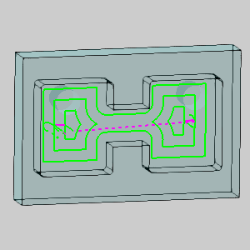
|
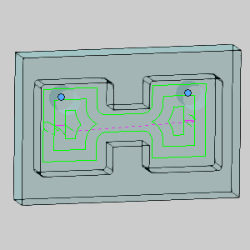
|
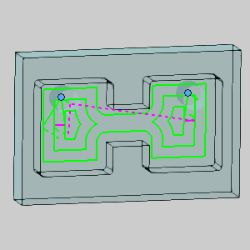
|
Mill 3 Axis Standard
Skip First Cut
A new option is available in the Parameters page of the Z Level Finish, called Skip First Cut which allows you to remove the first Z level cut from the toolpath. In most cases, a cut near the very top of the part is ideal. This can help deal with fillets along the top edge, and other similar circumstances. However, in some cases, this is not what the user is looking for. Now, with the Skip First Cut option, removing that first step is just one click away!
 Skip First Cut Skip First Cut |
 Skip First Cut Skip First Cut |
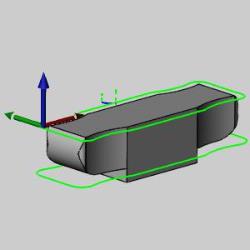
|
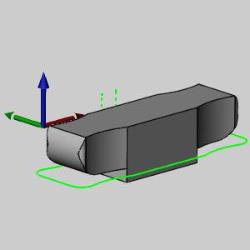
|
Mill 3 Axis Pro
Barrel Mill Tool Support
|
Supported Barrel Mill Tool Types:
|
|
Standard
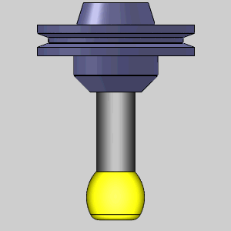
|
Advanced

|
|
Tangent
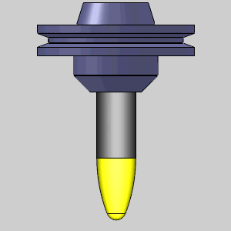
|
Lens
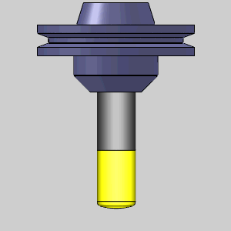
|
|
For the first time, BobCAD-CAM now support Barrel Mills for most operations. More and more companies are turning to Barrel Mills. Cutting with Barrel Mills can save an unbelievable amount of time and money. Until now, we've had no way to support these tools in your operations, but after working hand in hand with Melin Tool Company to test and retest, we can give you a product that puts this amazing tool in your hands. See the diagram below to get an idea of why these tools are quickly becoming the standard.
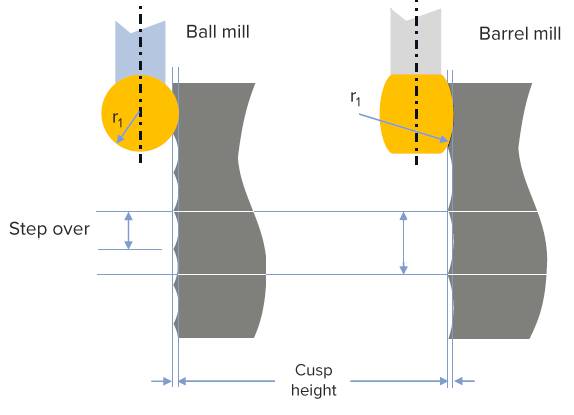
Note: It's easy to see how these tool shapes can save so much time! You can program a barrel mill tool with a much deeper step down and still leave the desired cusp height. Two additional barrel mill types can be utilized with the Mill 4 Axis Pro surface based toolpaths.
Advanced Rough Operation
Remove Corner Peg Options
New Smoothing options in the Options page of the Advanced Rough give you a couple new ways to remove corner pegs. Nice big stepovers are great for removing a lot of material fast, but if they get too big, you have an issue with corner pegs. Luckily, the Remove Corner Pegs option creates extra moves in the corners to eliminate these. In the images below, you can see the difference Remove Corner Pegs can make.
| Remove Corner Pegs Off
|
Remove Corner Pegs On
|
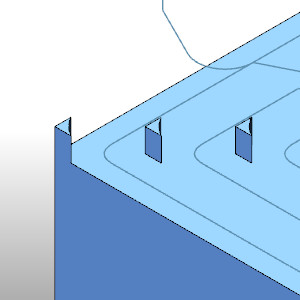
|
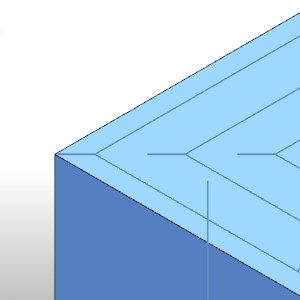
|
Although we have had this option for a while, there was only one method of creating the corner pegs, this was the Line-Arc-Line method. In this release, we are introducing another two methods of removing corner pegs. The Line, and Arc options provide you with a couple different ways of removing the corner pegs so you can use method that suits you best!
Use Lead-Out
The Advanced Rough now provides control over the Lead-Out option in the Leads page for all patterns but the Adaptive Roughing. Normally, when a wall was encountered on the last pass of the pattern, a lead-out was automatically applied. While this lead-out worked great in most cases, users have requested to have some control over the lead-out. In this version we now provide the controls to customize the size of this lead-out, or even to shut it off completely!
| Lead-out Off
|
Lead-out On
|
Lead-out size
|
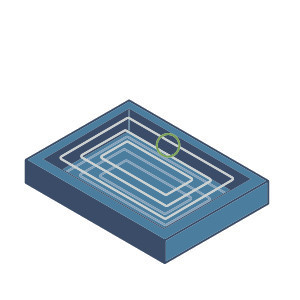
|

|
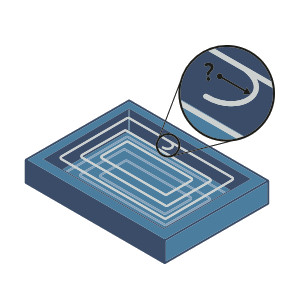
|
Wall Clearance
New option allows you to control the distance from the wall at which the tool is lowered back down to the full depth of cut. When using the adaptive roughing patter, the tool lifts to the link clearance height used and then lowers back down to make the next cut. In the past, there was no way to control how far away from walls the tool was when this occurred. Normally the distance that was used automatically was fine, however, there are cases in which you may need to engage the tool a little further away, and this feature allows you to do just that!
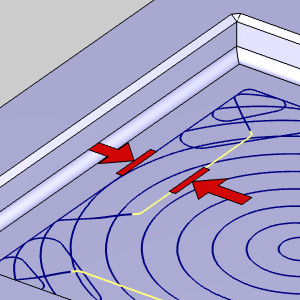
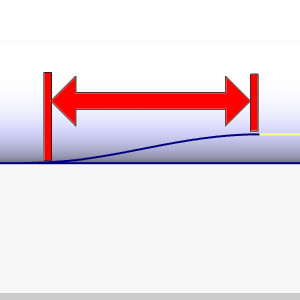
Advanced Z Level Finish
Remove Air Cuts
A new option to help refine what the tool attempts to machine in areas with undercut while using Lollipops, Barrel Mills and T-Cutters. The Remove Air Cuts option can be used to eliminate portions of cut that no longer contact the machining surface. When we first introduced Undercuts for the Advanced Z Level operation, it was huge! Finally, you could utilize your Lollipops and T-Cutters to create undercuts with a 3 Axis toolpath! Since then, we've provided the ability to focus solely on the undercut areas, added Barrel Mill tool support, and now, you can even remove portions of the undercut toolpath that don't contact the surface! Some parts require multiple setups, each with a bit of undercutting to finish the part. In the past, you could create an undercut toolpath, but any areas that didn't contact the final surface could be wasted cuts. With this new option, simply use the Remove Air Cuts option and BobCAD-CAM will trim away the unnecessary portions of toolpath, saving you time and money!
 Remove air cuts Remove air cuts
|
 Remove air cuts Remove air cuts
|
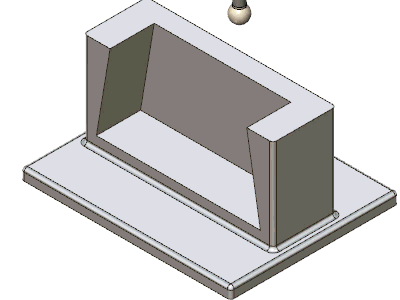
|
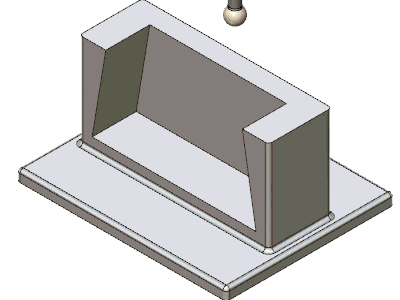
|
Flatlands Operation
Reverse Cutting Order
The Flatlands operation now has a Reverse Cutting Order method for the Offset pattern to allow you to flip from an inward cut to an outward cut. The Flatlands operation is a super handy operation that improved more and more over the years. However, users have requested a way to flip the order of the cuts so they can begin on the inside and work their way out, and in this release we're giving you just that! Select the Reverse Cutting Order check box, and you're done!
| Reverse Cutting Order Off
|
Reverse Cutting Order On
|
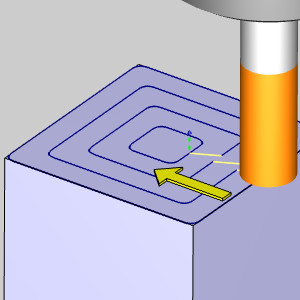
|
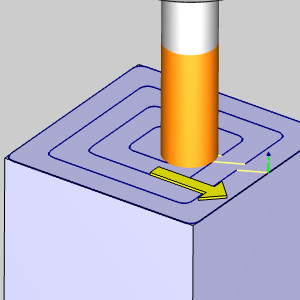
|
Equidistant Operation
Up / Down Cutting Feedrates
The Equidistant operation has new options in the Advanced Feedrates page to allow you to adjust cutting feedrate based on the direction of cut. This option is designed to optimize the tool loading and allows you to specify different feed rates for upward and downward cutting directions. We all know speed is the name of the game, but we still have to be cautious about how much material we engaging in certain areas, and with how much of our tool is being engaged in the cut. With a single speed for all areas, you would definitely want to choose the safe speed and just deal with knowing you could be going quicker in certain areas. The good news is that this version allows you to set your feedrate for the whole operation, and have additional control on top of that to increase the feedrates in areas of up cutting, and slow them down in areas of down cutting. Your life just got a little easier!
| Up Feedrate % - 150 |
Down Feedrate % - 50
|
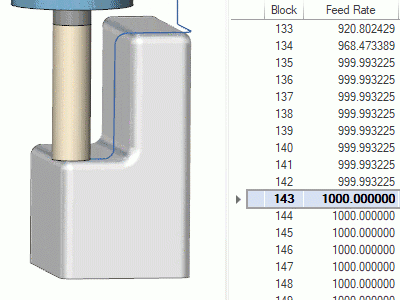
|
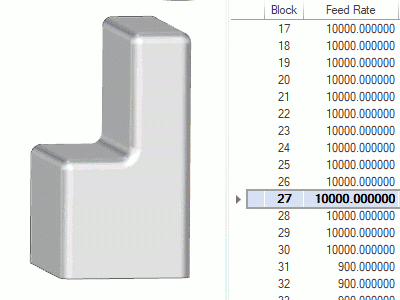
|
Advanced Planar Operation
Trim Adaptive Passes
Over the years, the Advanced Planar operation has come a long way. In this version, we offer a way to trim off the unnecessary portions of the Adaptive stepover option to leave only what is needed. When we first offered the Adaptive stepover for the Advanced Planar, it was a huge help. Finally, areas of the part, whose steep angle caused large gaps in the toolpath, could be handled in a single operation by creating additional cuts on those areas. The only issue this caused, was the additional cuts were applied across the entire part. This meant if the surfaces that needed those additional cuts didn't go all the way across the part, there were now a bunch of unnecessary cuts on some of the other surfaces of the part. With the Trim Adaptive Passes option, the rest of those unnecessary cuts are trimmed off, leaving the additional cuts only where they were intended.
 Trim adaptive passes Trim adaptive passes
|
 Trim adaptive passes Trim adaptive passes
|
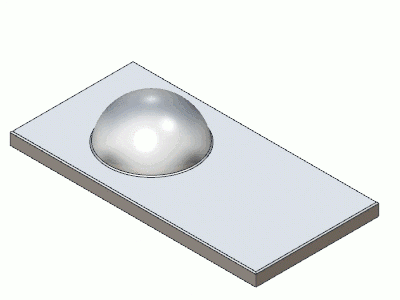
|
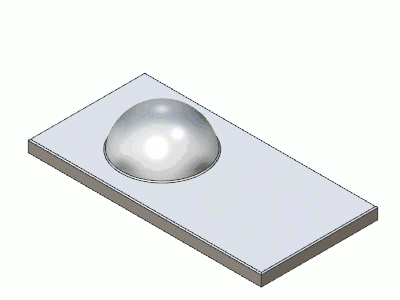
|
Mill 3 Axis Premium
Steep Shallow Operation
BobCAD-CAM is proud to introduce the new Steep Shallow operation. This new operation allows you to use two different toolpath styles in the same operation in order to handle the steep features and the shallow areas of the part with the cut styles that were made for them. In the past we offered toolpaths designed for steep areas, and toolpaths for shallow areas, and while we've added options to improve the cuts in the areas the other specializes in, never before have you been able to combine two different specialized toolpaths into a single operation. On top of all that, this toolpath brings some serious calculation speed to the table! While our Advanced Z Level Finish can calculate 8 times faster than our basic Z Level Finish operation, the new Steep Shallow operation is capable of calculations that are 78 times faster than our basic Z Level Finish. Bring some speed to your shop with the new Steep Shallow operation!
| Z Level + Planar
|
Z Level + Equidistant
|
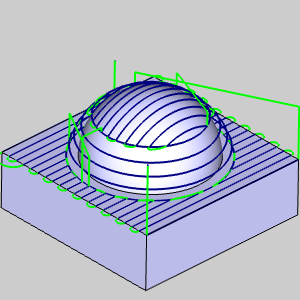
|
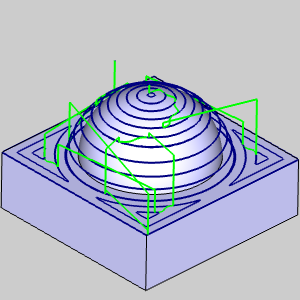
|
Mill 4 Axis Pro
Barrel Mill Tool Support
|
Supported Barrel Mill Tool Types:
|
|
Standard

|
Advanced

|
|
Tangent

|
Lens

|
|
|
Double
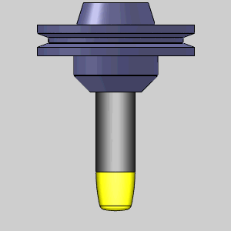
|
Section
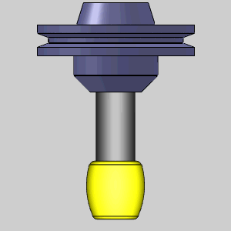
|
Taper
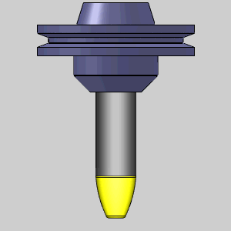
|
For the first time, BobCAD-CAM now support Barrel Mills for most operations. More and more companies are turning to Barrel Mills. Cutting with Barrel Mills can save an unbelievable amount of time and money. Until now, we've had no way to support these tools in your operations, but after working hand in hand with Melin Tool Company to test and retest, we can give you a product that puts this amazing tool in your hands. See the diagram below to get an idea of why these tools are quickly becoming the standard.

Note: It's easy to see how these tool shapes can save so much time! You can program a barrel mill tool with a much deeper step down and still leave the desired cusp height.
Intermediate Steps
The 4 Axis Advanced Rough now offers an Intermediate Steps option so you can bring the tool back through the remaining stock to help eliminate staircases. The Intermediate Steps option for 3 Axis Advanced Rough was a huge help when it came out. You could program your depth as deep as you dared and set a certain number of intermediate steps in the operation. Then, when your depth left large steps against the model, the intermediate steps would come back and focus only on those steps. It was a huge time saver. Now, for the first time, you can have that same power in a 4th Axis operation!
 Num. of Intermediate Step Num. of Intermediate Step |
 Num. of Intermediate Step Num. of Intermediate Step |
|
|
|
|
|
|
Detect Stock Thicker Than
The new Detect Stock Thicker Than option for the Number of Intermediate Steps option in the 4 Axis Advanced Rough is designed to eliminate unnecessary intermediate steps. The only issue with the Intermediate Steps, is that not all steps left against the model are created equal. Many of them weren't thick enough to cause a problem on the finish pass, but intermediate steps took those additional passes everywhere. Now, with the Detect Stock Thicker Than option, you finally have a way to specify steps that are not thick enough to worry about, and those will be ignored by the intermediate steps.
 Num. of Intermediate Step Num. of Intermediate Step |
 Num. of Intermediate Step Num. of Intermediate Step |
| ...Stock Thicker Than 0.000
|
...Stock Thicker Than 0.0626
|
|
|
|
|
|
|
Mill 5 Axis Pro
Automatic arc - tool axis orientation
The Automatic arc feature has a new option in the Tool axis orientation drop down list when the lead type is set to Automatic Arc. The new option is called Automatic, and it performs automatic tilting to avoid collisions based on the tool components and geometry selected for gouge checking. When the lead that is created during a process is not collision free, and if the gouge check job is not already set to TILT AWAY, it is automatically set to TILT AWAY and the maximum tilt angle is set to 90 degrees. This can be extremely helpful since this new option modifies only the lead moves to provide a more complete toolpath.
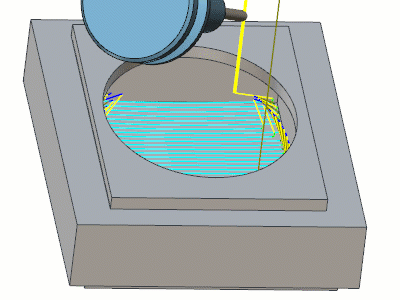
Limits relative to surface normal
The new Limits relative to surface normal option gives you to flexibility to set tilting limits based on the normal of the surface instead of tying the tilting limits to the initial tool orientation. One area that can be a little tricky is setting up tilting strategies for your gouge checks. Figuring out how much tilting you may need along the way can seem a little daunting. With the new Limits relative to surface normal option, things get a lot easier! Since it’s easier to know a safe angle for the tool to use at any given position on a surface, just select the check box, and set the angle range and you will know exactly how the tool will be tilted relative to the surface normal.
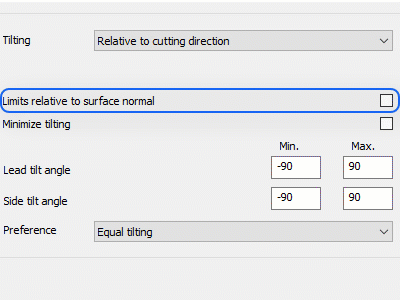
Multiaxis Roughing
Undercuts Machining
Undercuts machining lets you machine areas that are hidden from the normal orientation of a predefined floor surface. While the Multiaxis Roughing allows you to conform to curved floor surfaces to help create ideal path, it still does not handle areas that are undercut from the surface normal. With the new Undercuts Machining option, you can finally handle these undercut areas. This option also allows you to specify one of three options:
- Do not machine
- Machine
- Machine Only
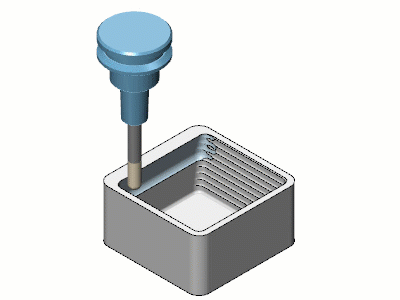
Extend Undercuts
With the addition of the Undercuts Machining comes an option to give you the control you need when using undercuts: Extend Undercuts. Smoother is always better when creating good toolpath. With the Extend Undercuts option, you can define a distance beyond the necessary endpoint of the undercut portions of the part. This helps to ensure a smoother transition into the rest of the toolpath.

Lathe
New Pecking Options
One of the most frequently requested features has been to include pecking options in more hole operations. In this release, BobCAD-CAM is giving you just that! While pecking has been an option in standard drill operations since the beginning, other operations have not had that functionality available. In this release you will find pecking options in the following operations:
- Mill
- Center Drill
- Counterbore Drill
- Chamfer Drill
- Ream
- Lathe
- Lathe Center Drill
- Lathe Chamfer
- Lathe Ream
Chip Break
In the world of machining, it's all about the chips, and chip control, and in this release BobCAD-CAM offers a chip break in all applicable Lathe operations. While there are a lot of top form geometry inserts designed to form chips that break themselves into the proper sizes automatically, a bird nest of unbroken chips can still be a headache in certain circumstances. With this simple chip break option, you can control the retract distance, and spacing between those retracts and ensure you get the chip size you're looking for every time!
 Chip Break... Chip Break...
|
 Chip Break... Chip Break...
|
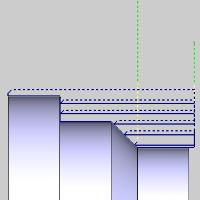
|
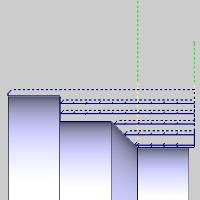
|
Simulation
Temporary Relative Jog Values
A new check-box has been added in the Set Axis Values window of the Axis Control docking pane in the Machine Simulator. The check-box is called Temporary Relative Jog Values and sets the current position of all the axes to 0 without changing the machine position on the screen. This allows the user to enter new values that are incremental to the current machine position.

Smooth cutting quality for cuts along the X- or Y-axis
In this release the simulation has been optimized to improve the look of the cuts along the X,Y Plane when using bullnose mill tools. Years ago the this same optimization was applied to tools cutting along the Z Axis which covered most cases, but there was a clear difference between those cuts in Z, and cuts along the X,Y Plane. Now, that same optimization has been applied to bullnose tools that are cutting along the X,Y Plane. While this feature is strictly cosmetic, getting a clearer image of the final product in simulation is something we can all get behind!
